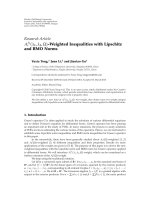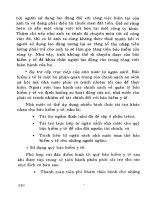3 1 2 lets make a trade
Bạn đang xem bản rút gọn của tài liệu. Xem và tải ngay bản đầy đủ của tài liệu tại đây (3.61 MB, 10 trang )
Suggested levels for Guided Reading, DRA,™
Lexile,® and Reading Recovery™ are provided
in the Pearson Scott Foresman Leveling Guide.
Let’s Make
a Trade!
by Marianne Lenihan
Genre
Expository
nonfiction
Comprehension
Skills and Strategy
• Sequence
• Draw Conclusions
• Summarize
Text Features
• Chart
• Captions
• Glossary
Scott Foresman Reading Street 3.1.2
ISBN 0-328-13326-4
ì<(sk$m)=bd cga< +^-Ä-U-Ä-U
Reader Response
Let’s Make
a Trade!
1. Place these events of Bartering Day in
order: some students bartered; students
displayed their items; students brought
items from home; students decided what
to barter
for. Lenihan
by
Marianne
1.
2.
3.
4.
2. Summarize the bartering between the
radio station and theater company.
3. Straying is used on page 6 as an adjective.
Its base word can be a noun, an adjective,
or a verb. Use the base word as a verb in a
complete sentence.
4. What were the dads able to barter on
pages 8 and 9?
Editorial Offices: Glenview, Illinois • Parsippany, New Jersey • New York, New York
Sales Offices: Needham, Massachusetts • Duluth, Georgia • Glenview, Illinois
Coppell, Texas • Ontario, California • Mesa, Arizona
Katie wants to learn to play the violin.
Tina wants to learn to ride a bike. If they
agree to teach one another these things,
then Katie and Tina have bartered.
Bartering is trading goods, knowledge,
or services with others. Barterers simply
trade what they have for what they need.
Every effort has been made to secure permission and provide appropriate credit for
photographic material. The publisher deeply regrets any omission and pledges to
correct errors called to its attention in subsequent editions.
Unless otherwise acknowledged, all photographs are the property of Scott Foresman,
a division of Pearson Education.
Photo locators denoted as follows: Top (T), Center (C), Bottom (B), Left (L), Right (R),
Background (Bkgd)
Katie knows
ho
to ride a bike w
.
Opener: (TL) Getty Royalty Free, (TR) Getty Royalty Free, (BL) Rubberball, (BR)
Rubberball; 1 Getty Royalty Free; 3 Rubberball; 4 ©DK Images; 5 ©DK Images; 6
Bridgeman; 7 ©DK Images; 8 Rubberball; 9 Rubberball; 10 ©DK Images; 11 ©DK
Images; 14 Getty Royalty Free; 15 Corbis
ISBN: 0-328-13326-4
Copyright © Pearson Education, Inc.
All Rights Reserved. Printed in the United States of America. This publication is
protected by Copyright, and permission should be obtained from the publisher
prior to any prohibited reproduction, storage in a retrieval system, or transmission
in any form by any means, electronic, mechanical, photocopying, recording, or
likewise. For information regarding permission(s), write to: Permissions Department,
Scott Foresman, 1900 East Lake Avenue, Glenview, Illinois 60025.
2 3 4 5 6 7 8 9 10 V0G1 14 13 12 11 10 09 08 07 06 05
s how
w
o
n
k
Tina the violin.
to play
3
Bartering began thousands of years
ago, before money was used. Farmers
traded crops for cloth to make clothes.
A blacksmith might have shoed the
horse of a merchant in trade for an
item from the merchant’s store.
Two men barter goods
in a medieval European
marketplace.
This merchant has
beads to barter.
Sometimes one person would
have to trade several small things for
one big thing to make the trade fair.
Suppose a carpenter has a big table. A
carpetmaker wants it. The carpetmaker
might have to trade three or four small
rugs for the big table.
4
5
Neighbors often joined together
to trade. They built houses for new
neighbors or barns for straying animals.
Each neighbor knew that his or her
work would be rewarded someday
when he or she needed help.
This woman is offering bread to trade for shoes.
American colonists and Native
Americans traded for what they wanted
and needed. Native Americans had
plenty of furs to barter for the cloth,
thread, and tools of the American
colonists.
6
7
Bartering is also a way for a family
to save money. Instead of using money
to buy items or services, families may
barter for what they need.
This way, they can keep their money
in the bank and still get what they need.
A family’s bartering plan might look
like this, once they have found another
family to barter with them.
Items or Services to Be Traded
Dad
Mom
Daughter
Daughter
Dad
Mom
Daughter
Son
knowledge
of how to
start a small
business
bread
machine
exercise
equipment
collection
of sports
cards
carpentry
work
food
processor
tutoring in
math
bike and
skateboard
The Smith Family
8
Items or Services to Be Traded
The Jones Family
9
Today, people barter in many ways.
Bartering partners can be found on
the Internet and in newspapers and
magazines. They can be found in your
neighborhood.
Businesses barter with other
businesses. What might bartering look
like in the marketplace? Here is one
example.
A community theater company needs to advertise its
summer plays, but it doesn’t have enough money. It
does have an entire floor of empty offices.
A local radio station needs office space. It will
run ads for free for anyone who can provide
office space.
SOLUTION: The community theater barters
its office space for free advertising on the
radio station.
10
11
B
To understand bartering better, a
class of third graders decided to have a
“Bartering Day” with their teacher’s help.
The students each brought one item to
school that they no longer wanted.
12
On Bartering Day, each student showed
his or her item. The students then decided
what they wanted to barter for.
Most students found items they
wanted. Some made several trades before
they were finished bartering. Others
decided to keep their own items.
ering Day!
t
r
a
13
The next time you decide to trade an
item or a chore, think about its value and
the value of what you might be trading for.
You might decide to wait for a better offer.
Before you decide to barter anything,
check with your parents! Your parents will
know the value of almost everything in
your house. They will know whether it’s
OK for you to barter something. Once you
have permission, have fun bartering!
Talk to your parents first about the value of
items you want to barter.
$
$
$
14
15
Reader Response
Glossary
carpenter n.
someone whose
work is building
and repairing things
made of wood.
carpetmaker n. a
person who makes
carpets and rugs for
floors.
knowledge n. what
you know.
marketplace n. a
place where people
meet to buy and sell
things.
merchant n.
someone who buys
and sells goods for a
living.
plenty n. a full
supply; all that you
need; a large enough
number or amount.
straying adj.
wandering.
thread n. a very
thin string made of
strands of cotton,
silk, wool, or nylon,
spun and twisted
together.
1. Place these events of Bartering Day in
order: some students bartered; students
displayed their items; students brought
items from home; students decided what
to barter for.
1.
2.
3.
4.
2. Summarize the bartering between the
radio station and theater company.
3. Straying is used on page 6 as an adjective.
Its base word can be a noun, an adjective,
or a verb. Use the base word as a verb in a
complete sentence.
4. What were the dads able to barter on
pages 8 and 9?
16









